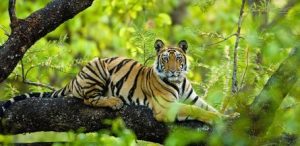
Bandhavgarh Tiger reserve located in the eastern Satpura hill range of Umaria and Katni Districts. Mythologically the name “Bandhavgarh” means (Bandhav = Brother and garh = Fort) and was acquire the name Bandhavgarh with the name of the fort. This fort was built and given to brother Lakshman by Lord Rama, to keep a watch on Lanka and hence it acquired the name.
Bandhavgarh National Park consists of a core area of 716.90 Sq. Kms and a buffer area of approximately 820.03 Sq. Kms of topography varies between steep ridges, undulating forest and open meadows.
Bandhavgarh is best known for evergreen Sal forest and mixed forest about 515 species of plants are found here and is also home to 242 species of birds. Major mammals of Bandhavgarh is Royal Bengal Tiger (it has the highest density of tigers), Leopard, Wild dog, Wild Cat, Hyena, Wolf, Chital, Sambar, Black Buck, Rojda etc.
It is the first Naqtional Park in India to launch ‘The Hot Air Balloon Safari’ for tourists. You can now explore the unseen gems of Bandhavgarh National Park at its resplendent best. An aerial view of the restricted buffer zone and core zone will be an exclusive experience for the safari lovers.
How to reach
Nearest Airport – Jabalpur Airport (170 Kms)
Nearest Railway Station – Jabalpur Railway Station (170 Kms)
Umaria Railway Station (30 Kms)
Katni Railway Station (90 Kms)
Best Time to Visit – October – June
October – January – During this time one can enjoy greenery of forest, plenty of water sources and migratory birds around them. Similarly, tigers can also be seen as water sources remain alive and grasslands will ease the availability of prey in those areas.
February – March – In the months of February and March, flowers in Flame of Forest tree make the jungle more photogenic and attract birds around them, sloth bears to come out more frequently. With the presence of Mahua (Madhuca longifolia), the fruit of Indian Butter Tree attracts most of the herbivores and omnivores animals of Bandhavgarh forest. Sambars, Blue-bull, Sloth Bear, Spotted deer, Languar monkeys can be seen more often in open.
April – June – These months are considered the best time to do wildlife photography and tiger photography. During this time, we can expect unusual photography of tigers as heat causes animals to remain close to water sources.
Safaris
Four wheeler open gypsy takes you to the core and buffer tourism zone of the park for Safaris.
Regular Safari – Two Safaris in a day, Morning (5 Hrs) and Afternoon (3 Hrs)
Full Day Safari – It lasts from morning till evening from 6.00 Am to 6.00 Pm.
Timing varies as per forest guidelines and as per summers and winters.
*Note – Park is open for tourists from 1st October – 30th June. Entry for park round is in the morning and in the evening Park remains closed for tourists in the afternoon of Wednesday.
